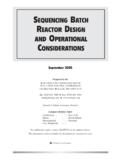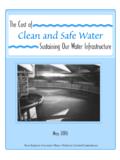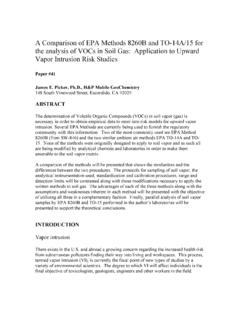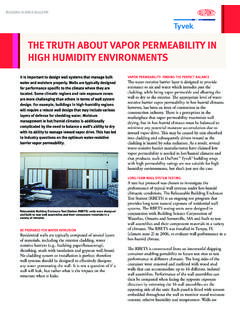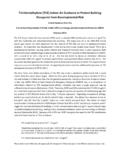Transcription of Evaluating the Impact of Methane in Soil Gas on the ...
1 1 Use this area for cover image (Maximum height & width 8cm) Evaluating the Impact of Methane in Soil Gas on the Potential for vapor intrusion of Petroleum Hydrocarbons Methane from Biofuels Webinar, NEIWPCC Wednesday, October 8 from 1:30 4:00 (EDT) George DeVaull 25 minutes 2 Webinar Outline approach to evaluate the Impact of Methane in soil gas on the potential for vapor intrusion of petroleum hydrocarbons George DeVaull, Shell Global Solutions US Inc. response to spills Mark Toso, Minnesota PCA Methane is formed in the subsurface using case studies of sites , surface spills, and ecological impacts research on ethanol blended fuel spills and potential for Methane generation and transport Bill Rixey, University of Houston 3 By way of Acknowledgement: Wilson, J.
2 T., M. Toso, D. Mackay, N. de Sieyes, G. E. DeVaull, What s the Deal with Methane at LUST Spill Sites? Parts 1& 2: LUSTLine, #72, February 2013; #71, September 2012. Ma, J., W. G. Rixey, G. E. DeVaull, B. P. Stafford, P. J. J. Alvarez, Methane Bioattenuation and Implications for Explosion Risk Reduction along the Groundwater to Soil Surface Pathway above a Plume of Dissolved Ethanol, Environ. Sci. Technol., 2012, 46, 6013 6019. Sihota, , O. Singurindy, and K. U. Mayer, 2011. CO2 efflux measurements for Evaluating source zone natural attenuation rates in a petroleum hydrocarbon contaminated aquifer, Environ.
3 Sci. Technol., 45:482-488. Sepich, J. E., Methane Soil Gas Identification and Mitigation, ASCE San Antonio, April 20, 2012. Eklund, B., Proposed Regulatory Framework for Evaluating the Methane Hazard due to vapor intrusion , EM Magazine, Air & Waste Management Asso., , February 2011, 10-14. 4 Overview: Potential Methane Issues Potential Sources: Biogenic Methane from organic sources Natural gas transmission and distribution systems Reservoirs and storage, coal, petroleum, natural gas Representative Examples: Measurement of shallow Methane in the course of a vapor intrusion investigation Risk evaluation of some motor fuels (>E20) for Methane and vapor intrusion potential KEY IDEAS: Determine how much Methane is okay.
4 Both concentration and flux (or flow) are important. 5 Biogenic Methane : What s the issue? Biogenic Methane generation makes gas: ethanol (liquid) Methane (gas) carbon dioxide (gas) Example (with some steps missing): Similar for other organics, including petroleum (gas) (gas) (gas) (gas or liquid) Compare to Methane oxidation: can be equal volume or decrease 6 Methane Scenarios / Conceptual Model flammable liquid releases to enclosed spaces; explosion overpressure consequences; emergency response; mitigation methods; climate change NOT COVERED cess pool in crawl space bubbling / gassy water well effervescent tap water shallow Methane source vapor sourcebuilding enclosuresurfacesoil layerFocus Area Here: Shallow Soil Gas to Enclosure Migration 7 Overview: Risks and Hazards Methane Hazards: Direct: Flammability In enclosures; not within soil gas LFL (LEL) Lower Flammability Limit: v/v in air (21% O2) Toxicity Asphyxiation (O2 displacement ); same as some other gases (N2, He, Ar.)
5 For Methane toxicity criteria are higher than flammability criteria Indirect: Effect on other chemicals O2 demand for biodegradable chemicals induced advection PART 1 PART 2 8 Methane Flammability: Concentration and Flow (or Flux) Concentration Within enclosure - flammable > In soil gas potentially flammable once mixed with air > Flux or Flow Enclosure (crawlspace) > 5 to 95 L/min ; to m/day Enclosure (residential) > 57 to 230 L/min ; to m/day KEY POINT: Flammability requires both high Methane concentrations and high flow or flux. Values above for 100% LFL.
6 Safety factors ( 10% LFL for human-occupied spaces) often applied. PART 1 9 Hazard Screening: Methane in Shallow Soils Review / existing information: known risks & hazards of Methane Comparison to guidance on mine safety, natural gas distribution systems, municipal landfill gas migration, feedlots, Methane seeps, regional ordinances Table: screening criteria Table based on Eklund (2011) and Sepich (2008) 1 10 Methane Soil Gas Hazard Screening: Interpretation Other Comparisons / Notes / Examples Guidance: California DTSC manure A Guidance Prepared for the Evaluation of Biogenic Methane in Constructed Fills and Dairy Sites, California EPA, Department of Toxic Substances Control, March 28, 2012 San Diego rescinded ordinance 1999.
7 Methane discovered in San Diego housing developments; 2001. Ordinance imposed. June 2002. MTRANS ( Methane Transport Model) April 2005. San Diego County repeals ordinance requiring Methane gas testing on mass graded lots within the unincorporated areas of the County. GET Soil Gas Criteria (<5%, <30%) overestimates potential enclosure risk Differential Pressure (2-in H2O) okay for relatively impermeable caps (intact concrete, silt, clay); otherwise might need adjustment Other possible options: 11 Methane Detection: care needed in measurement Landfill Gas meters, handheld meters (nominal) absorption band For Methane Responds to other hydrocarbon gasses Also responds to ethanol Carbon Filter Trap ?
8 In front of detector Traps most hydrocarbons Ethanol not sorbed by carbon Methane absorption Ethanol absorption Hexane absorption Jewell, K., J. T. Wilson, Ground Water Monitoring & Remediation, 31, 2011, 82 94. IR Spectrum Petroleum and ethanol also detected by IR gas meters! 12 Soil Gas Modeling: can use a combination of methods *errors increase for higher concentration, concentrations, and pressure gradients Ref: Thorstenson and Pollock (1989) 1 13 Example: Field Data Vertical profile Methane in soil gas Lundegard, et al., 2000 71% CH4 + 23% CO2 = 94% at depth 78% N2 in air must have been displaced Peclet number Data Solution of Stefan-Maxwell equations Unidirectional diffusion of (CO2 + CH4) in stagnant air (N2 + O2) Model Thorstenson and Pollock (1989) 1 mole fraction 14 Additional Parameter: Nitrogen Gas Low values of differential pressure are hard to measure The potential for significant advection may also be evaluated by measure of nitrogen (N2) in soil gas.
9 Nitrogen is nearly conserved Ensure the N2 value is measured directly; or reasonably estimable by a balance of all of the other gases and vapors. for diffusive flow 1 15 (m) Methane (%) Methane : in wet soils VadoseLayerCapillaryFringePorosity = Moisture = = Moisture = CH4 (1 ppm)10% CH470% CH4 Pevadose = (>1) diffusion-dominantPecap = (>1) advection-dominant295 cm5 cmCH4 flux = m3/m2-dayExample 70% Methane at bottom of a (wet) capillary fringe Peclet numbers Add (in layers): Petotal = Pecap + Pevadose = ( >1 ) advection-dominated 16 Conclusions: Methane Flammability Methane Screening Concentrations in soil gas can be relatively high (5%, 30%) and still conservative [that is, overestimating potential flammability risk].
10 Advective contribution Flux can be high enough to generate a pressure gradient Differential pressure criteria (2-in water) can be measurable under an intact cap (concrete, clay) Measure of nitrogen deficit in subsurface soil gas can also indicate displacement / advection due to Methane gas flow In Soil Gas Screening: PART 1 KEY IDEAS: Acceptable Methane screening values are high (>5%, > 30%. Both concentration and flux (or flow) are important. 17 Potential effect of Methane Scenario: Methane dominant oxygen sink dominant source of advection Benzene Low levels Sand Soil Typical concrete foundation Source to foundation: 3m Apply : Oxygen-Limited Aerobic Biodegradation With Methane Advection PART 2 On transport and degradation of other chemicals (benzene) 18 Screening methods Exclusion Distances (source to foundation separation distances) Examples: 6 ft dissolved phase source, 15 ft LNAPL source EPA OUST Draft Guidance, reports Lahvis et al.)
